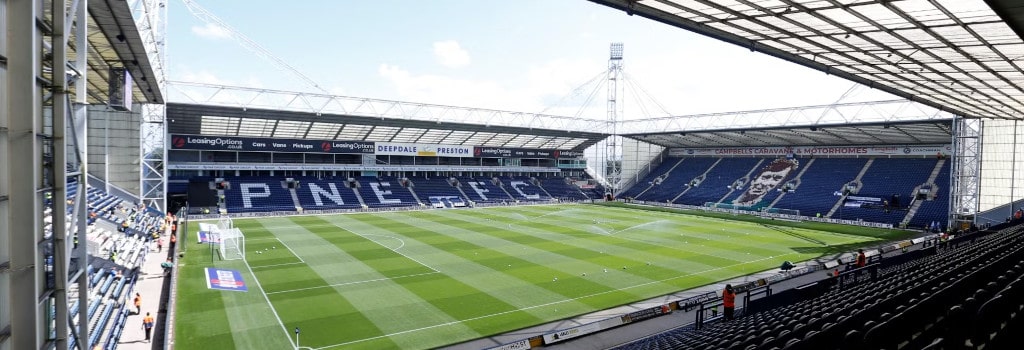

Preston North End may not be topping the headlines these days, but a firm just down the road is quietly changing football stadiums across the country. ADI, based in Preston, supplies the digital screens you've likely seen at some of England's biggest grounds. From LED boards to in-stadium video displays, their work has become part of the modern matchday backdrop. Now that the company is expanding, it raises a question for clubs of all sizes: is this the future of football grounds, and should everyone be following their lead?
ADI might not be a household name for most fans, but you've likely seen their work. From Anfield to Elland Road, their LED boards, perimeter screens and big-match visuals are part of the live experience. They handle the digital backdrop of countless English games, and their presence stretches from football grounds to motorsport venues like Silverstone.
Recently, the company was given the green light to expand its Preston HQ. This includes new production facilities, more staff, and a push into AI-driven content delivery, designed to improve how visual information is delivered on matchdays. That's not just big news for local job creation. It speaks to something much larger: the growing role of digital tools in how we watch and experience football.
The surge in digital stadium tech is not an isolated situation. It's aligned with changes in how football is consumed, particularly when it comes to betting. Where once fans placed their wager at the local shop before heading to the ground, now in-play options dominate.
This is where stadium screens have made a real difference. Live odds, key match stats, and even real-time updates are now visible during the game, not just on phones but on the stadium displays themselves. That kind of visibility brings the action closer to fans who are already tuned into betting markets during the 90 minutes.
On matchday, several UK betting sites don't just serve remote punters anymore. They're actively part of the live experience. Some clubs even partner with betting operators to show up-to-date odds directly on stadium screens. This has changed how people follow the game.
It's not just stats and odds either. A number of clubs are testing more immersive content, real-time replays, player cams, and pitch-level AR elements. According to a BroadcastNow report, some venues are rolling out screens that offer fans in the stands an experience closer to a live TV broadcast. While not yet the standard, it shows where things might be heading, especially at grounds investing in more screen infrastructure.
It's one thing to see digital screens in a 60,000-seater arena. But what about League One? Or the National League? Not every ground needs to look like a tech showroom. Yet there's a case to be made for even the smaller clubs to consider digital upgrades. Done well, they don't distract from the football; they make the experience smoother.
Take safety announcements, quick changes to kick-off times, even community messages or tributes. These can be delivered clearly and visibly, with the flexibility that old boards can't match. There's also the chance to raise extra revenue through sponsored segments, helping clubs balance the books without charging fans more for tickets or pies.
Still, the concern remains: at what point does it all become too much? Where does the authentic matchday experience end and the overly-produced spectacle begin?
One crystal clear thing, though, is that fans don't want their stadiums turned into a theme park. A ground doesn't need bells and whistles to hold meaning. It needs atmosphere, decent sightlines, and a proper sense of occasion. Overdoing the digital elements can strip away the very soul of a football match.
When used wisely, tech like ADI's can complement the experience rather than overwhelm it. Clubs that still use chalkboards or worn-out score displays aren't holding onto charm; they're falling behind. A good digital setup helps engage fans without asking them to stare at their phones. It can connect the dots between old habits and new expectations.
The truth is, stadium tech doesn't need to be divisive. It doesn't have to be a case of "this or that." It can sit alongside the traditions fans hold dear. Nobody is saying to replace the roar of the crowd with pre-programmed sound effects. But when Preston's ADI is showing how a mid-size firm can lead the way in smart stadium presentation, it makes you wonder why more clubs aren't taking notes.
There's a middle ground between overdone spectacle and underwhelming infrastructure. It's not about being flashy, it's about being prepared. Whether it's sharing matchday replays, real-time updates, or simply offering clear, visible communication in the ground, there's a benefit to getting it right.
Tony Incenzo has been to over 2,000 football grounds - is he the world's barmiest football fan? Read about his love for Non-League football and groundhopping obsession, including watching a match in prison!
My daughter's first ever football match - Orlando City v Atlanta United, August 2019. Written for Izzy to read when she gets old enough. Vamos Orlando
The 91 biggest football stadiums in Europe. From Manchester to Munich, Villa Park to Valencia - each one with a capacity over 40,000
An in-depth look at the biggest football attendances ever recorded, from the 1950 World Cup to pre-season friendlies in the States and the Scottish ground with dozens of 100,000+ attendances
